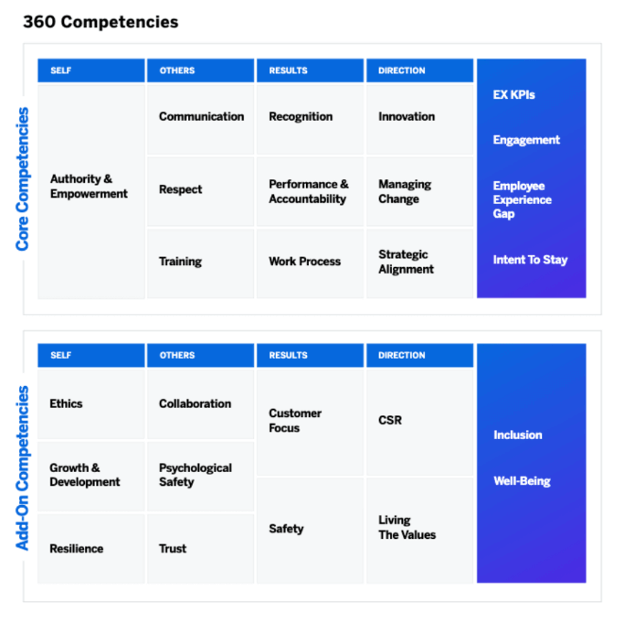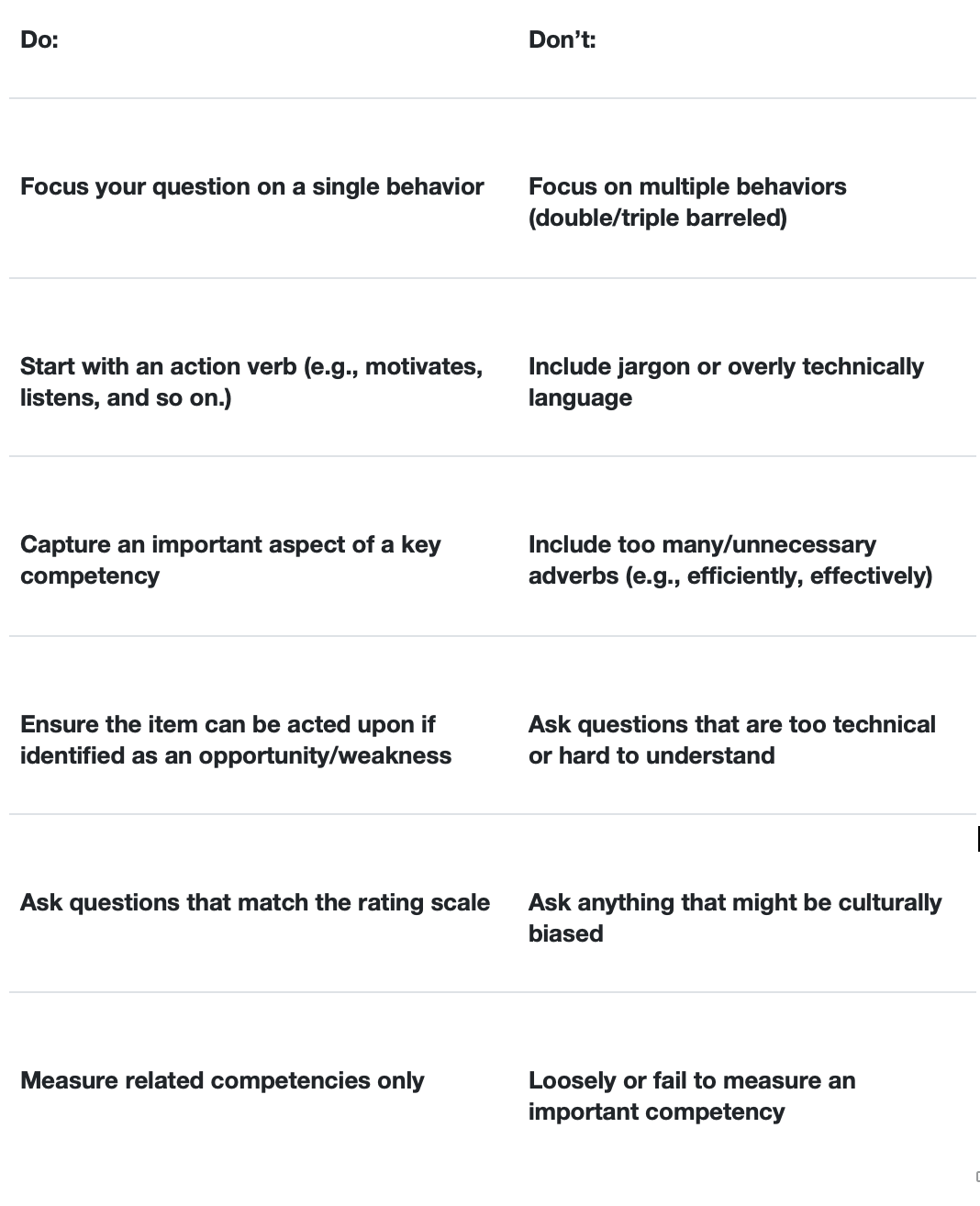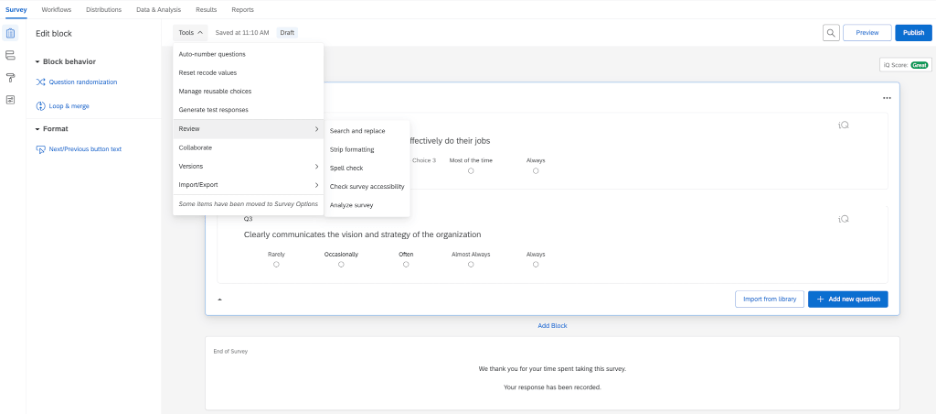What is 360 degree feedback?
360 degree feedback (also known as multi-source or multi rater feedback assessment) is a way for individuals to understand their personal strengths and weaknesses, using the constructive feedback of others who work with them the most. It’s a development tool for individual leaders and employees – the combined insights from the collective feedback process is then used to inform an individual’s development plan.
Here, we will help you to understand more about what 360 degree feedback is, when you should use it, and the steps you need to take to implement an effective program that will help develop your people into more effective leaders. And you can download our ebook, Best Practices: 360 Feedback, to find out even more.
Who can give an employee 360 degree feedback?
360 Development is multi rater feedback. This means it should be given by those colleagues who work directly with the person who’s receiving the feedback. This can include supervisors, colleagues, direct reports, customers, and vendors.
It’s also best practice to choose a reviewer who has worked with the subject for six months or more. They will have a more consistent experience of the employee’s behaviour, by working with them, and seeing them experience various scenarios at work.
Assessments vary according to an employee’s placement within the organisation. Some 360 degree feedback surveys target HiPOs (high-potential employees) or C-level leadership and executives, whereas others may target the grassroots level (e.g. field employees), managers or frontline leaders, or mid-level management (e.g. directors or VPs).
Hub article: Find out how to develop great leaders with 360-degree feedback
Why you should only use 360 degree feedback for development
Many clients ask us about the ideal use case for 360 degree feedback. At Qualtrics, we believe that 360 should never be used to assess employee performance. We feel that feedback is a gift that helps your people to develop their skills and pinpoint areas of improvement, as well as encouragement to keep on doing the things that they may not have realised made a positive impact. It is a development tool, not a performance management tool.
Feedback must be:
- seen as an investment in an employee through feedback from peers, direct reports, managers, leaders, and customers
- an authentic review (not a political tool) for developing your employees and not evaluating them
- distributed via an anonymous online feedback form
Feedback must NOT be:
- used for performance appraisal
- a tool that determines employees’ pay, performance, or promotion.
360 degree feedback vs. performance reviews
There is still a place for performance reviews in the workplace. Where 360 degree feedback is a tool for development, performance appraisals are tools for reward, and they can sit alongside each other quite comfortably. Here are the main differences between them:
| 360 degree feedback | Performance Review | |
|---|---|---|
| Goals and end results | As 360 is all about development, it is continuous, no end in sight. | Recognises the achievement of a finite, set goal |
| Contextual | Data-driven | Performance management is all about the metric. Once the measurement has been achieved, there’s no more follow up. |
| Follow-ups and future plans | Managers, direct reports and the employees themselves provide anonymous feedback that can be brutally open and honest, with the objective of developing people. | A performance review cannot be anonymous, as the employee knows their raters, and conversations happen face to face. |
| Rewards and Competition | There’s no competition with 360 degree feedback, which may otherwise prevent raters from giving supportive feedback. All 360 is about is development, not prizes. | A performance appraisal is competitive, with employees in competition for rewards, prizes, recognition and promotions. |
| Perception | The 360 degree feedback process is synonymous with development, and perceived by employees to be exactly that. | The performance appraisal is generally perceived as a feedback process that results in rewards – usually material ones. |
The pros and cons of 360 degree feedback
When done effectively, the benefits of a 360 include:
- Increased employee self-awareness
- A balanced view of the organisation as well as the broader growth and development strategy and expectations
- Identifying strengths and weakness in employee skill sets in order to build on or improve upon them
- Building a culture of feedback that allows for open communication
- Ensuring successful succession planning;
- Generating an optimal flow of identifying training opportunities
When done poorly, some of the downsides of 360 degree feedback include:
- Fear of retribution or anxiety over poor working relationships in the future
- People feeling overburdened by the workload involved
- Heavy costs of getting consultants to facilitate the process
- Lack of follow-up leading to apathy around the effectiveness of the process
7 steps for designing an effective 360 degree feedback review program
Qualtrics 360 Development helps you develop all levels of talent across your organisation to close talent gaps and accelerate organisational performance.
Following this seven-step framework, you will be able to successfully deliver an actionable 360 development program that empowers your employees to quickly identify and close their talent gaps so they can become better leaders and drive greater business impact.
Step 1. Set clear goals
It’s critically important to identify clear goals when starting a 360 assessment program for leaders, managers, or individual contributors. As mentioned above, we strongly recommend that a 360 assessment be utilised purely for developmental purposes, not performance reviews.
Here’s why: When feedback is tied to performance rating, pay, or promotion, it can negatively affect the fidelity of responses from raters or sometimes be viewed as a political tool. The reason for this is often the scarcity of promotion opportunities and rewards in organisations. Peer feuds can be created by feedback mechanisms and a phenomenon known as “sandbagging” can take over where self-interests trump the investment in developing others.
However, when the purpose of a 360 program is purely developmental, such conflicts of interest can be avoided.
Step 2. Train raters
Before getting started with 360 assessments, we recommend that you provide adequate training for anyone who will be involved in the rating process. Proper training ensures consistency in how feedback is provided.
When raters are trained to operate from a standpoint of providing feedback that will positively impact a person’s growth, the exercise can create positive momentum for engagement, productivity, and better, more honest relationships with colleagues, leaders, and direct reports.
Step 3. Focus on natural strengths
We also recommend a strengths-based approach to development where the primary focus is on an individual’s natural strengths rather than areas that do not come most naturally. Focusing coaching on only developmental areas will give only incremental results while focusing on people’s natural talents can provide exponential growth.
Step 4. Involve managers and leaders
Wherever possible in the process, involve managers and leaders to convey clearly what is being asked of their teams. Encourage them to spend time with each of their employees through both formal and informal check-ins.
Likewise, managers must be supported and informed in advance about how to communicate the feedback results by specifically focusing on desired behaviours on the job. It’s also important to coach them on setting behavioural goals for their team members while setting up the program.
Step 5. Create buy-in and trust in the 360 development program
It will be critical to engage senior leader champions for a successful 360 development program. Take the time to educate and reiterate the importance of feedback and how it helps to address future skill needs of the organisation as well as provide development to employees.
Development is considered one of the top benefits provided by employers. Stress clarity of roles and hold all stakeholders accountable for their roles (Subjects, Managers, Evaluators) while entailing what is expected of each of them.
Step 6. Know what to ask and how to ask it
Now that you’ve laid the groundwork, it’s time to start designing your 360 feedback program. Ideally, your 360 assessments should not exceed 30 to 40 total items to avoid survey fatigue. Keep in mind that a rater could be providing feedback to multiple employees.
Also note that no more than 8-10 competencies should be included in the assessment. This helps employees understand the most critical competencies to their success in the role.
Learn more about how our new 360 Development framework exemplifies this approach here.
Here are examples of 360 competencies that you might want to include in your assessments:

As for rating scales, we encourage you to use frequency scales (Rarely > All the time) instead of “agree to disagree” scales. This will help evaluators focus on the consistency of important behaviours. If you are using open text items, phrase them in a way that it leads direct evaluators to identify concrete examples of demonstrated behaviours or provide actionable feedback for improvement.
Here are some other helpful tips for navigating the right items to ask about in your 360 assessment.

Step 7. Personalise the 360 degree feedback program to your organisation
One of the biggest advantages of using our 360 Development solution is that you can design a program by and for your organisation. You can use your own competency model, an external consulting model, or a hybrid of the two. The 360 Development solution affords the flexibility to ask exactly what is required for the organisation.

How to get the most out of your 360 degree feedback
Consider the future
What are some of the key cognitive and behavioural skills that will become indispensable to the organisation in the future? If clients identify some critical skills for the future, through their 360 degree feedback programs, they can not only build a pipeline of leaders and champions who can pave the way forward but also identify where learning and development initiatives should be focused using our organisational dashboards.
Scale the effort
Every employee wants investment. In fact, professional development is considered the top benefit when choosing an organisation. It is important to make development accessible to people across the organisation and ensure that every employee’s career is nurtured in a personalised manner. Scaling the assessment can also ensure that our clients can scale development by using organisational insights to see where the biggest gaps and strengths exist in the workforce.
Keep it confidential
If employees believe their responses won’t be kept confidential, this can lead to issues related to honesty in giving feedback, increased fear of retribution, negative experiences, and/or organisational culture decline. Anonymous feedback is the bedrock of your 360 program.
Ensure that confidentiality is built in, maintained, and clearly communicated. Raters provide more useful feedback when they know they cannot be identified.
Carefully consider costs
This doesn’t just mean the monetary costs, but time commitment for your people too. Make sure that there are parameters around your process. This should include the length of 360 assessment, and number of raters.
Check out how you can use 360-feedback to develop your people
Don’t just listen, act
It’s crucial that 360 degree feedback is actioned. An employee needs to be given resources to help them if they’re given negative feedback in a particular area.
A lack of follow-up around what happens after going through feedback means that the process becomes pointless. It will also damage future attempts at carrying out effective 360s as employees will be apathetic about how useful it’ll be.
Make sure that you can provide the resources needed in order to help support them if needed.
Our 360 degree feedback development tool
360 Development by Qualtrics is an ideal solution for human resources in your organisation to better support and develop your employees. It will give you the insights you need to drive career development, personal development, enhance employee performance, productivity, and engagement.
Our 360-degree feedback tool helps you to:
- automate the process of multi rater reviews with faster, simpler anonymous feedback
- empower managers to hold more actionable conversations based on trends and analysis from 360 degree feedback data
- deliver individualised reports to employees and protect raters’ anonymity with built-in confidentiality features
- connect 360 Development insights to other solutions within the Qualtrics EmployeeXM platform to take action on the whole employee experience
- identify development gaps across your organisation and track success outcomes over time
Develop your people for the future with our 360 Development solution